The Search for the Portrait that Belonged to Kittel Pages at The Face Of Bach
The Queens College Lecture of March 21, 2001 - Page 2 - The Conundrum of the Lost Portrait
The Face Of Bach
This remarkable photograph is not a computer generated composite; the original of the Weydenhammer Portrait Fragment, all that
remains of the portrait of Johann Sebastian Bach that belonged to his pupil Johann Christian Kittel, is resting gently on the surface
of the original of the 1748 Elias Gottlob Haussmann Portrait of Johann Sebastian Bach.
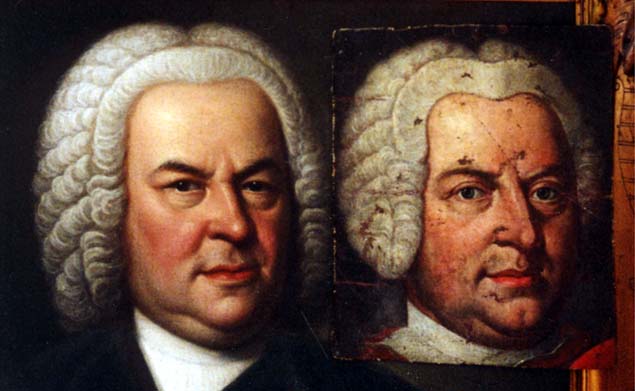
1748 Elias Gottlob Haussmann Portrait, Courtesy of William H. Scheide, Princeton, New Jersey
Weydenhammer Portrait Fragment, ca. 1733, Artist Unknown, Courtesy of the Weydenhammer Descendants
Photograph by Teri Noel Towe
©Teri Noel Towe, 2001, All Rights Reserved
The Search for the Portrait that Belonged to Kittel
The Queens College Lecture of March 21, 2001
Page 2
The Conundrum of the Missing Portrait
Of course, the legendary, the redoubtable, and the utterly formidable Arthur Mendel, the co-Editor with Hans Theodore David of
The Bach Reader, was also living in Princeton. Profs. David and Mendel had gotten stung, and stung but good, in 1945, when they
put out the first edtion of the legendary and indispenable anthology The Bach Reader. They were persuaded to use as the
frontispiece a then recently discovered painting that was alleged to be a portrait of Bach by Haussmann that dated from about the
time that Bach moved to Leipzig from Cöthen, in other words about 1723.

I first had seen this image when I was about eleven, in the copy of The Bach Reader that I found in the Performing Arts section of
the old Greenwich Public Library, and I recall that, even then, I found it both puzzling and unconvincing, although I could not then
articulate why. But I distinctly remember that it did not look like Bach to me; even then, it was not the face I knew.
The credibily of the image began to unravel in 1950, when the 1748 Haussmann portrait surfaced. By 1964, the fact that the painting
was, in fact, a forgery brilliantly conceived by Manfred Gorke, had become documented, public knowledge. The best succinct
statement of the affair is provided, ironically, by Gerhard Herz, the musicologist who announced the painting's existence to the
world in 1943, on page 177 of his invaluable 1985 book, Bach Sources in America.
In the long run, the decision to make this portrait the frontispiece of The Bach Reader proved a lingering embarrassment for Profs.
David and Mendel, and, by the time that he prepared the Revised Edition in 1966, Prof. David having moved on to other endeavors,
Prof. Mendel not only had become a "strict constructionist" with regards to any questions concerning the Bach iconography but
also had become a member of the Princeton University faculty and the Chairman of the Music Department. It therefore comes as no
surprise that the "bogus Bach" of the 1945 edition was replaced by the 1748 Haussmann portrait.
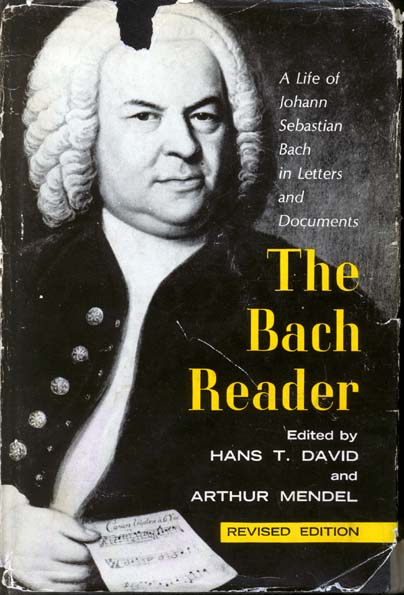
Both the 1945 edition and the 1966 edition of The Bach Reader contain a second portrait of Johann Sebastian Bach, a reproduction
of the earliest portrait print, which was not engraved until 1774, nearly a quarter of a century after Bach died.

This print was engraved by Samuel Gottlob Kütner, a school chum in Leipzig of C. P. E.'s son, Johann Sebastian II, the namesake
of his grandfather and a talented artist who died too young, at the age of 30.
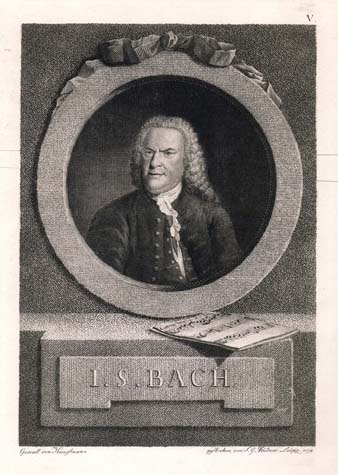
The Kütner print is fascinating for several reasons. First of all, it is the only portrait of Johann Sebastian Bach about which anyone
within his own family is known to have left an evaluation. On April 20, 1774, Carl Philipp Emanuel Bach sent a letter to his father's
first biographer, Johann Nicolaus Forkel, in which he pays the engraving a backhanded, carefully worded, and arguably sarcastic
compliment that long has intrigued me: "..., I shall have the pleasure of dispatching to you a recent copper engraving, finely done,
and a fair likeness of my dear late father's portrait." Please note that C. P. E. says that it is a fair likeness of the portrait; he does not
say that it is fair likeness of his father, per se.
Another interesting question concerns Kütner's own access to the 1748 Haussmann portrait, which, by the 1773-1774 academic
year, was in Hamburg with C. P. E., who had succeeeded his godfather Georg Philipp Telemann as that city's Director musices in
1768. That he was a friend and student colleague of the younger Johann Sebastian is documented, but when and where did Kütner
see the 1748 version of the Haussmann, on which the engraving is clearly based, in order to copy it, if he actually saw the original at
all?
One plausible scenario: Kütner took a vacation trip to Hamburg with his school chum, and the project was conceived, undertaken,
and completed then and there. But, while that is possible, it somehow seems unlikely that Kütner actually engraved the image
directly to the plate in C. P. E.'s home, with the 1748 Haussmann portrait in front of him. It would have been easier for him to make
a good reference drawing from which to work at his leisure upon his return to Leipzig.
There is another possible scenario, however, that should not be overlooked. Johann Sebastian the Younger was himself an artist
after all, and a good one. Is it not possible that it was he who made a now apparently lost "Stichvorlag" drawing of the 1748
Haussmann portrait of his grandfather, from which Kütner then engraved his portrait print?
But I am getting much too far afield! If you share my fascination with this unusual image and its many implications, please have a
look at the page devoted to it at my website, The Face Of Bach.
As I said, Prof. Mendel was an arch-conservative when it came to the Bach iconography. He had put his hand on the hot stove
once, and he was not about to get burned again. In the Supplement to the Revised Edition of The Bach Reader, Prof. Mendel
added an impassioned discussion of the various putative Bach portraits; he was particularly harsh on the image familarly known as
the Meiningen Pastel:

"Whether one sees in it any strong resemblance to the Bach of the Haussmann portraits is perhaps a personal
matter", Prof. Mendel wrote; "the editors do not." (Mendel '66, pp. 424)
The problem, of course, is exactly that: The Meiningen Pastel is not a portrait based on the Haussmann model and therefore, at least
initially, comes as something of a shock to those with the Haussmann portraits firmly embedded in their souls. The Meiningen
Pastel is almost a miniature, measuring about 6 inches wide by about 9 inches tall. It is the equivalent of a large snapshot in size.
But, despite the many attempts to discredit it and to cast doubt on the family tradition that accompanies it, the Meiningen Pastel has
the best shot at the one thing that neither of the Haussmann portraits has: a clear and arguably unbroken provenance.
And therein lies a rub: If provenance is the primary factor, the Meiningen Pastel becomes the standard, and the Haussmann portraits
become "also rans".
But, no matter what the issues, no matter how contentious those issues, and no matter what the resolutions of those issues, one
conundrum of Bach portraiture so far has remained unsolved, and almost defiantly so.
The Fermat's Last Theorem of Bach iconography for at least a century and a half is the gnawing question:
What became of the portrait of Bach that belonged to his pupil Johann Christian Kittel (1732-1809), for more than a half a century
the organist of the Predigerkirche in Erfurt?
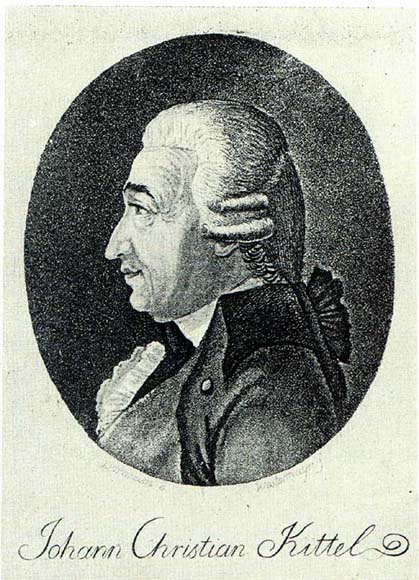
This portrait, which disappeared from sight after it was sold at the auction of Kittel's estate late in 1809, always has held a particular
fascination for those of us who are interested in what Bach looked like, at least partly because the tantalizing bits of information that
have been handed down to us make it clear to anyone who considers the sources carefully that the portrait was painted earlier than
the familiar Haussmann portraits and that it depicts a Bach who might have looked substantially different from the Bach familiar to
us from the Haussmann portraits.

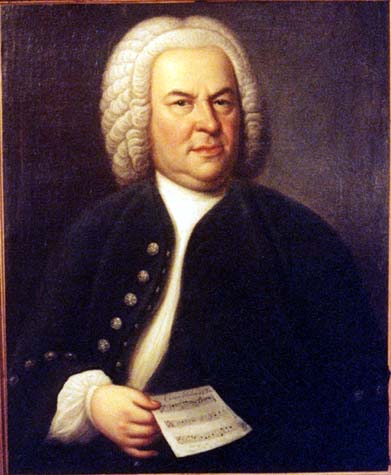
But how different did the Bach of the Kittel portrait look, and how would we know that the portrait that belonged to Kittel is, in fact,
the portrait that belonged to Kittel when and if it ever does turn up?
The Kittel portrait is also a source of fascination not only because did it disappear without a trace, but also because no supplicant
for recognition as the long lost portrait that belonged to Kittel has ever matched completely what little we know about the portrait's
appearance.
What are our sources of information? They are, essentially, four.
The first two of these are the two entries to be found in the legendary Lexikon that was assembled by Ernst Ludwig Gerber
(1746-1819), the son of one of Sebastian Bach's most devoted pupils, Heinrich Nicolaus Gerber. That the Gerber Lexikon is a
major source of information about the portrait that belonged to Kittel is particularly significant, because of the close relationship
between Bach and the lexicographer's father.
Ernst Ludwig Gerber's obsession with composer iconography was even greater than mine is, and it led inexorably to the assembly
of a series of volumes on music and musicians that remains an invaluable and essential research tool to this day. Because Gerber
had personal contact with, and first-hand knowledge of, many of the personages and images on which he reports, his commentaries
have shown themselves to be particularly reliable. In addition, his having cut a deal with the Gesellschaft der Musikfreunde in
Vienna for the purchase of his amazing collection during his own lifetime assured not only the preservation of the resources that
made his life's work possible but also the easy accessibility to most of his source material, if necessary. (I write "most" because, as
Othmar Wessely, who prepared the indispensable, annotated modern facsimile reprint of the Neues hist.-biogr. Lexikon der
Tonkünstler, points out in his entry on Gerber in the "New Grove", "At his death, however, his collection seems not to have passed
to the new owners in its entirety..." [ed. S. Sadie, New Grove, Vol. 7, p. 247, London, 1980])
The first reference to the portrait of Bach that Kittel owned is contained iin the biographical entry on Johann Christian Kittel that
appears in the 1812 edition of the Neues hist.-biogr. Lexikon der Tonkünstler, Volume 3, column 58. Here is a scan of the passage
in question, the source of the famous anecdote about Kittel's unusual method of rewarding his pupils for having performed well
during a lesson:
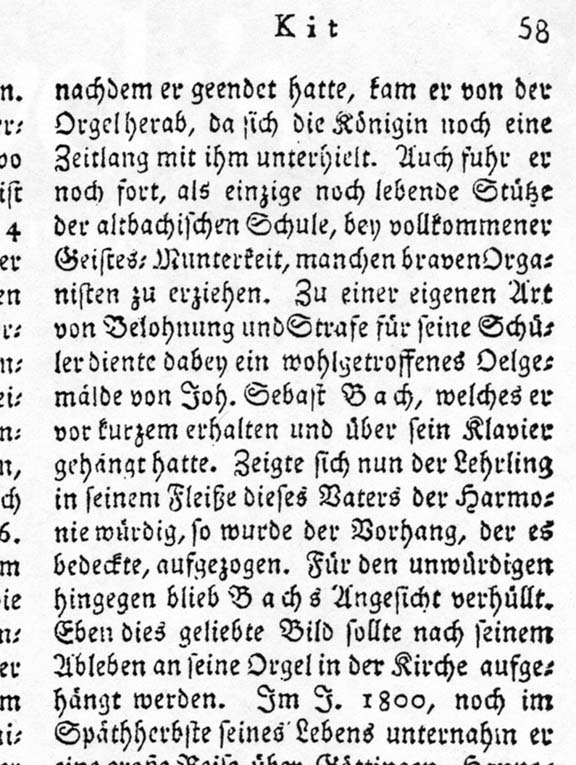
Here is the translation of the passage that Prof. Mendel provides in the 1966 Edition of The Bach Reader:
"As a special form of reward and punishment for his pupils [Kittel] used an oil painting of Joh. Sebast. Bach -- a fine
likeness -- which he had recently acquired and hung over his clavier. If a pupil showed industry worthy of this Father of
Harmony, the curtain covering it was drawn aside. For the unworthy, on the other hand, Bach's countenance remained
hidden." (Mendel '66, pp. 425-426)
Gerber provides additional information about the painting, and how Kittel acquired it, in Volume 4 of the Lexikon, which was
published in 1814. Here are scans of that passage, which is spread over columns 735 and 736 and is part of an alphabetically
organized inventory of composer portraits:


Here is the passage, translated into English:
"Bach (Joh. Sebast.) Painted in oils and very well preserved, collection of Mr. Kittel in Erfurt. He acquired it in 1798 in
Langensalza; probably from the Estate of the Duchess of Weissenfels. Also painted in oils at the Thomasschule in
Leipzig."
The last sentence is somewhat vexing, because it is unclear whether Gerber means that Bach sat for the portrait in his residence
within the Thomasschule or he is alluding to a second oil portrait of Johann Sebastian Bach, namely the 1746 Haussmann portrait,
which had been in the Thomasschule since 1801/1802, the year that it was brought there by August Eberhard Müller when he took
up his duties as Thomascantor, and then given by him to the Thomasschule in 1809, when he resigned the Cantorship and moved to
Weimar as Court Capellmeister.
Although Gerber himself does not directly connect Kittel's acquisition of the painting to the particular occasion, in the biographical
entry from which I quoted earlier, he refers to another important event in Kittel's career that took place in that year:

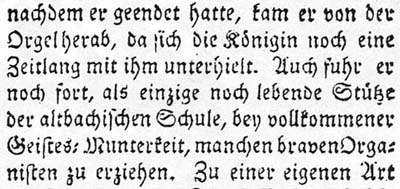
Here is a translation of the pertinent parts of the passage:
"Kittel had the honor, on November 24, 1798, of playing the organ in Predigerkirche [in Erfurt] for the widowed Queen
of Prussia, the Duke of Weimar, the Prince of Homburg and the Prince of Schwarzburg-Rudolstadt....and, after he had
finished, he came down from the organ loft, and the Queen conversed with him for quite a long time."
It is assumed by Werner Neumann, in his exhaustive and informative commentary on the various Bach portraits, real and unreal, that
appears at the back of his remarkable photographic anthology, Bilddokumente zur Lebensgeschichte Johann Sebastian Bachs
(VEB Deutscher Verlag für Musik Leipzig, Leipzig, 1979), the 4th Volume of the indispensable Bach-Dokumente series, and by
other scholars as well, that Kittel received the portrait of Bach as a gift from these noble personages on that occasion, but there is,
as yet, no independent proof of the validity of that assumption.
The third source of information on the lost portrait of Bach that belonged to Kittel is the biography of Sebastian Bach by Carl
Ludwig Hilgenfeldt that was published in Leipzig in 1850, in conjunction with the commemoration of the centenary of Bach's death.
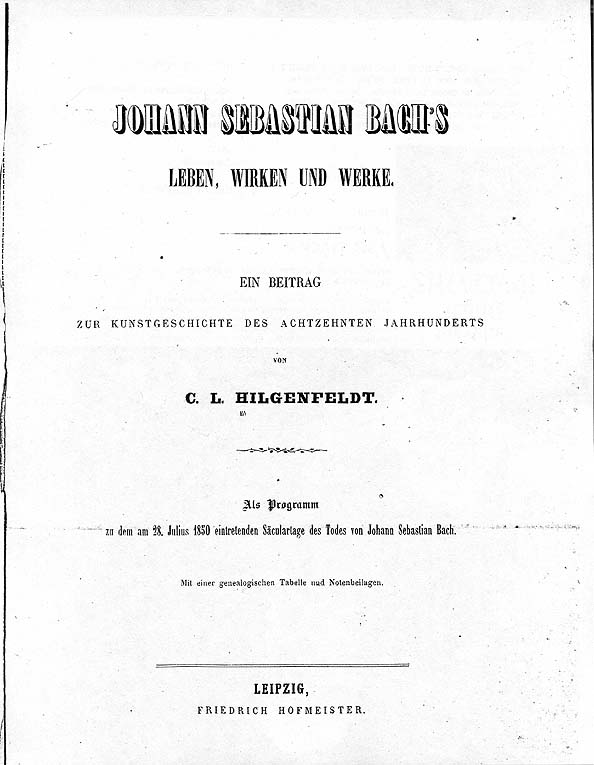
On page 169, three pages from the end of his monograph on Johann Sebastian Bach, Carl Ludwig Hilgenfeldt begins a discussion
of the portraits of Johann Sebastian Bach with a description of the oil painting of Bach that belonged to Johann Christian Kittel that
contains a tantalizing detail that is not to be found in Gerber's Lexikon.
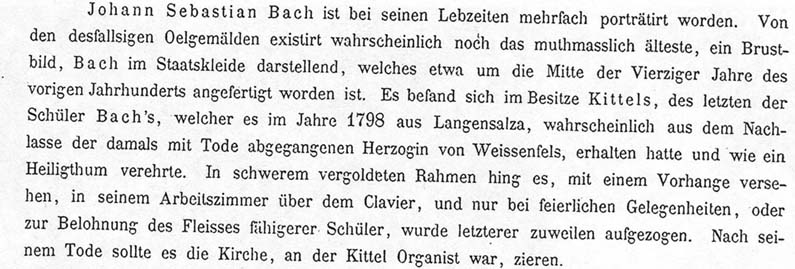
In English, Hilgenfeldt's description is best translated as:
"Johann Sebastian Bach had his portrait painted many times during his lifetime. Of the various oil paintings that
existed, probably the oldest [i.e, the earliest to be painted], was a bust portrait in which Bach is presented in official
regalia, that was completed in the fourth decade of the last century. It was to be found in the collection of Kittel, the
last of Bach's pupils, who obtained in 1798 from Langensalza, most likely from the Estate of the deceased Duchess of
Weissenfels, and who preserved and revered it like a holy relic. It hung in a heavy gold frame, covered by a curtain, in
his studio, over the clavier.... After his death, it was to be hung in the Church at which Kittel was the organist."
Yet again, we have to deal with wording that is vexing. The most problemmatical words in Hilgenfeldt's description are "um die
Mitte der Vierziger Jahre des vorigen Jahrhunderts". What does he mean by "Vierziger Jahre"? Most have understood this to mean
the 1740s, but, if Hilgenfeldt does mean the 1740s, the description of the painting as "das muthmasslich älteste" ("probably the
oldest", i.e., the earliest to have been painted) makes little, if any, sense, particularly since Hilgenfeldt accurately describes the 1746
Haussmann portrait, which by then had been in the Thomasschule for almost 50 years, a few paragraphs later.


If, however, one interprets "Vierziger Jahre" as meaning the fourth decade, i.e., the 1730s, Hilgenfeldt's description of the portrait
that belonged to Kittel as "probably the oldest" makes perfect sense.
But it is Hilgenfeldt's physical description of the painting that is most intriguing:

Hilgenfeldt wrote: "... ein Brustbild, Bach im Staatskleide darstellend". This passage is almost always translated incorrectly, but,
regardless of the accuracy of the translation, Hilgenfeldt's description of the appearance of the painting, is, to the best of my
knowledge, unique. The specific statement that the portrait is a bust portrait and, more importantly, that it depicts Bach in official
regalia of one kind or another (something, as I have already hinted, that sets the Kittel portrait apart from every other known
authentic image) implies either that Hilgenfeldt had actually seen the portrait or that he knew someone who had and who had
described it to him.
How accurate are Gerber's and Hilgenfeldt's accounts?
Werner Neumann explored the question in some detail in the commentary to which I referred a couple of minutes ago. (At this
point, I must say that Prof. Neumann's Bilddokumente zur Lebensgeschichte Johann Sebastian Bachs is a research reference tool
that is worth its weight in gold. This oversized volume also weighs about as much as a gold brick, and I never pick up my copy that
I do not recall with gratitude that Mordy and Irma Bauman showed me the kindness of schlepping a copy back from the DDR for
me at a time when the book was well nigh impossible to obtain in the USA.) The English translation of Prof. Neumann's
commentary that is provided in Bilddokumente was made by Anne Wyburd, and it is entitled "The Principal problems of Bach
Iconography - 18th Century Portraits of Bach supported by documentary evidence".
I will now read most of her translation of the text of Professor Neumann's account of the portrait that belonged to Kittel, interjecting
my amendments, corrections, and comments at the appropriate points:
"The lexicographer Ernst Ludwig Gerber (II/4, 1814, col. 735) reported that Johann Christian Kittel (1732-1809),
organist at the Dominican church in Erfurt and a former pupil of Bach's, owned a portrait: 'Mr. Kittel in Erfurt owns a
very well-preserved oil-painting Bach (John. Sebast.). He obtained it in 1798 from Langensalz, perhaps from the estate
of the Duchess of Weissenfels. Also painted in oils in St. Thomas's School in Leipzig.' This duchess is not of course, as
many suppose the 'Louise Christine' mentioned with 'Prince Christian' in Bach's Hunting Cantata, for she died at
Weissenfels in 1738, but Friderike, second wife of the next and last Duke Johann Adolph II (who ruled from 1736 to
1746), who after the incumbered Weissenfels residence had been closed and sequestered in 1746 lived in the
dower-house in Langensalza until 1775.
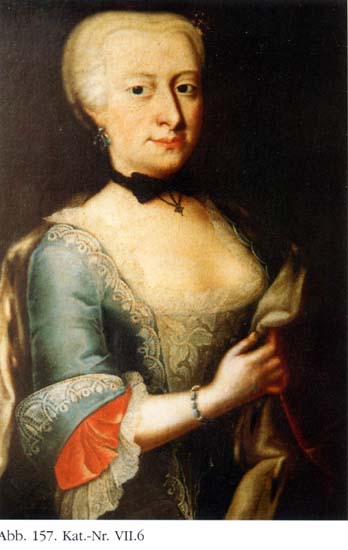
The reliability of Gerber's information does not therefore seem to be wholly proved."
Nor, conversely, has its reliability been disproven. Accepting, arguendo, that the painting came originally from the collections of the
Dukes of Sachsen-Weissenfels, Gerber's statement cannot be considered unreliable unless and until the household records of the
Duchy, for the Augustusburg and the erstwhile Hunting Lodge in Weissenfels as well as the Dower House in Langensalza, have
been shown not to include the painting. I might add that the possibility that the painting had made its way to the Dower House in
Langensalza suggests that Kittel might have seen the painting for the first time as early as 1751, the year after Bach's death, because
his first job after leaving Leipzig was as a school teacher and organist in Langensalza. He stayed there for five years, until he moved
back home to Erfurt, where he lived and worked for the rest of his life. If during his five years in Langensalza he had occasion to
visit the Dowager Duchess, it is well nigh impossible to believe that he would not have been shown the portrait. At that point, the
face of Bach, on which Kittel was among the last to gaze, would still have been fresh in his mind. Such an encounter with the
portrait, of course, also would have alerted him to its existence.
Prof. Neumann continues:
"Kittel's acquisition of the portrait is probably connected with the organ recital of 24 November 1798, also fully
documented by Gerber (II/3, 1813, cols. 57/58), which he gave in the Dominican church before four noble personages
(the widowed Queen of Prussia, the Duke of Weimar, the Prince of Homburg and the Prince of
Schwarzburg-Rudolstadt) and after which 'the queen talked to him for a while'. In another place (II/2, 1813, col. 58)
Gerber describes how 'a close likeness in oils of Joh. Sebast. Bach which he had recently received and hung over his
piano' was by drawing a curtain back and forth made to serve 'as an original way of rewarding or punishing his pupils...
After his death this beloved portrait was to be hung on the organ in the church.' Carl Ludwig Hilgenfeldt (1850) fills in
some details: 'Bust, showing Bach in robes' - 'painted in about the mid-forties of the last century' - 'in a heavy gilded
frame'."
I have already mentioned the uncertainty about what Hilgenfeldt means by "vierziger Jahre", but there is one more significant part of
the translation that is inaccurate.
Hilgenfeldt wrote: "... ein Brustbild, Bach im Staatskleide darstellend".

By translating "Staatskleide" as "robes", Anne Wyburd has jumped to a conclusion for which she has no basis, a conclusion which
implies an assumption of fact that she has no grounds for making. "Staatskleide" means, literally, "State clothing", or, to put it more
colloquially, "official regalia", "uniform", "livery", or "finery". In addition to Bach's official cantorial robes, evidencing his office
within the Thomasschule and the Thomaskirche, the term "Staatskleide" encompasses, at least, (1) official regalia as Director
musices of the City of Leipzig, (2) official regalia as Court Composer to the Elector of Saxony and King of Poland, and (3) official
regalia as Capellmeister von Haus aus to the Duke of Sachsen-Querfurt und Weissenfels; perhaps Bach's official ties to the
Paulinerkirche, the Leipzig University church, brought with them the prerogative of wearing a certain type of academic gown, too.
What these kinds of garments looked like, and what their colors were, obviously is a matter of crucial importance to the task of
authenticating any aspirant to the title "The Long Lost Portrait of Bach that belonged to Kittel."
Back to Prof. Neumann:
"Lively debate has arisen around this information on the style, origin and location of this picture and different
hypotheses have been evolved, some believing it depicts Bach in his old age (Kittel, who was one of his later pupils
found it a 'close likeness',"
That Kittel found it a close likeness does not mean that the painting dates from Bach's last years; such an unjustified conclusion
becomes even less defensible when one considers that Kittel's first encounter with the painting may have taken place as early as a
year after Bach's death.
Prof. Neumann again:
Hilgenfeldt dated it at 'about the mid forties',"
As I have already pointed out, not once, but twice, there is a problem (or, at least, a potential one) with the translation. Hilgenfeldt
wrote "etwa um die Mitte der vierziger Jahre des vorigen Jahrhunderts angefertigt". Ms. Wyburd, and others, have translated
"vierziger Jahre des vorigen Jahrhunderts" as "about the mid-forties" or the equivalent. But, as I remarked earlier, is that what
Hilgenfeldt actually meant? Could "vierziger Jahre" have meant "fourth decade" to a mid 19th century Saxon? If such an
interpretation is plausible, the portrait would date from the mid 1730s, and Hilgenfeldt's statement that the Kittel portrait was the
oldest of the four that he knew no longer seems odd, as Prof. Neumann suggests later in his commentary.
Prof. Neumann once more:
"Gerber connected it with the St. Thomas's School picture)"
This time it is Prof. Neumann who jumps to the wrong conclusion. Gerber wrote: "Auch in Oel gemalt auf der Thomasschule in
Leipzig". Admittedly, my German is not the best, and this is early 19th century German, but, as I said earlier, I interpret this
statement to mean either (1) that there was a second oil painting of Bach, and that it was at the Thomasschule, which was, in fact,
the case by the time Gerber wrote this statement, since August Eberhard Muller had given the 1746 Haussmann portrait to the
School in 1809, when he resigned the Cantorship to take the position of Capellmeister in Weimar, or (2) that Bach sat for the oil
painting in his apartment in the Thomasschule. The first seems the more accurate interpretation of the passage, but, no matter what
the accurate translation is, the passage definitely does not say that Kittel's portrait was in any way linked to the portrait in the
Thomasschule.
Prof. Neumann:
"and some in middle age, since Duke Christian, to whom Bach was Kapellmeister until 1736, obviously commissioned
it."
That the portrait may have been painted on commission for Duke Christian of Sachsen-Querfurt und Weissenfels (1682-1736) has
important implications, implications that ought not to be underestimated.
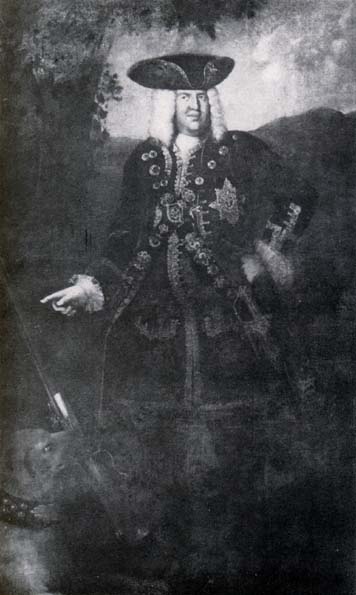
If the portrait was painted at Duke Christian's command, Bach himself would have had little control over either the form or the
content of the painting. Those decisions, ultimately, would have been Duke Christian's or the as yet unidentified portraitist's.
Christian von Sachsen-Querfurt und Weissenfels was paying the bill and therefore able to dictate the details of the commission, and
for that reason Bach would have had little influence on the form and content of the portrait. Bach, therefore, would have been in a
position quite different from that in 1746 and 1748, when he sat for Haussmann and paid for the portraits out of his own pocket.
Furthermore, if the portrait that belonged to Kittel was painted at the instigation of Duke Christian, it would have been logical for
Bach to be portrayed in his "public" persona and that he would sit for the portrait in his official regalia as Capellmeister vonHaus
aus, a clear indicium of his high stature within the Saxon musical and cultural hierarchy in general and within Weissenfels court
circles in particular.
Finally, if it were painted for one of the Dukes of Sachsen-Querfurt und Weissenfels, the portrait would not likely have been painted
for Christian's successor, because, upon his accession, Duke Johann Adolf II, who was the General Feldmarschall of the Elector of
Saxony and King of Poland's army, promptly disbanded the court's permanent musical establishment and disbanded it completely,
apparently keeping only the resident Capellmeister, Georg Lenck, on full time salary. It is not likely, therefore, that he had any urge
to commission a portrait of the Capellmeister von Haus whose honorary title he had just completely extinguished, although, to be
fair, it is possible, considering his exalted position within the King-Elector's circle, that Johann Adolf II used his considerable
influence to advance Bach's ultimately successful campaign to obtain a similar title from the King-Elector.
Prof. Neumann:
"Attempts have been made to identify it with the disputed portrait of Bach in old age [the Volbach portrait], the
Haussmann replica of 1748, C. P. E. Bach's Haussmann portrait or an unknown portrait which vanished in about 1812."
The 1748 Haussmann cannot be the Kittel portrait because it does not match the description; Bach is not dressed in "Staatskleide"
in either of the two Haussmann portraits.


The Volbach Portrait must be eliminated on the same grounds.
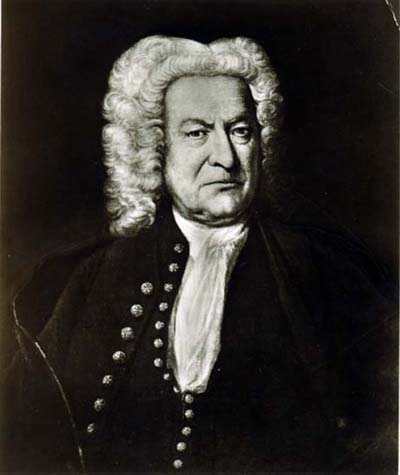
What the portrait that "vanished in about 1812" may or may not have been is yet another subject for investigation, but, for the
present at least, that enigma is way outside the scope of this presentation.
Prof. Neumann, once again:
"There is no reliable foundation for Albert Schweitzer's fanciful and often quoted story: 'During the Napoleonic Wars
when the church was used as a hospital, it disappeared with other valuable paintings. The French soldiers sold old Bach
to a junk-dealer for a few glasses of schnapps.' (J. S. Bach, Leipzig 1908, p. 147)
Most of these theories and legends are discredited by a document not yet evaluated in this context -- the 1809 estate
and auction catalogue from Erfurt entitled 'List of musicalia and musical writings from the estate of the deceased
organist Mr. Kittel of Erfurt, to be auctioned on Tuesday, 24 October and the following days ...' On p. 39 of this
catalogue we have: 'Bach (Joh. Seb.) Kapellmeister and Music Director in Leipzig. Painted in oils, 2 feet 4 inches high,
2 feet wide. In gold frame'. (Measures in Prussian feet; thus 73.2 x 62.8 cm.) This remarkable similarity to the
description in the list of C. P. E. Bach's estate dated 1790, in spite of slightly different measurements and no artist's
name, makes it almost certain that it came from his collection, which is known to have remained intact until 1797, so
that Hilgenfeldt's statement of 1850 about the four portraits known to him (Kittel, C. P. E. Bach, St. Thomas's, Anna
Amalia) oddly enough describing the first as apparently the oldest, must be regarded as inconclusive."
As I have already pointed out, there may well not be any reason to describe "Hilgenfeldt's statement of 1850 about the four portraits
known to him (Kittel, C. P. E. Bach [Haussmann 1748], St. Thomas's [Haussmann 1746], Anna Amalia [von Liszewsky copy of
Haussmann 1748])" as "oddly enough describing 'the first as apparently the oldest'...."
The auction catalogue, of course, is our fourth and final source of information about the portrait of Bach that belonged to Kittel,
and it is of great value because it gives us a clear idea of the size and shape of the painting.
But, and this is an important "but", to allege that the painting that belonged to Carl Philipp Emanuel Bach and the lost portrait that
belonged to Kittel are one and the same by relying on the close similarity of the dimensions of the painting sold at the auction of
Kittel's effects to the dimensions of the Haussmann portrait that left the hands of C. P. E. Bach's heirs in 1796 or 1797, months
before Gerber tells us that Kittel obtained his, is to build a house upon the shifting sands of wishful thinking. The coincidence is just
that, a coincidence, nothing more, and nothing less. I suspect that it was no different in the 18th century than it is today.
Commercial portraits came in standard sizes. Painters worked in standard sizes, particularly when painting on commission, and they
kept stretchers and canvas, pre-cut, in stock, and the price varied, to some extent, on the size image that the client selected. This
surmise presents a practical consideration that ultimately will have to be investigated and confirmed, but this old photograph of the
Council Chamber in the Altes Rathaus in Leipzig provides an interesting gloss on the issue:
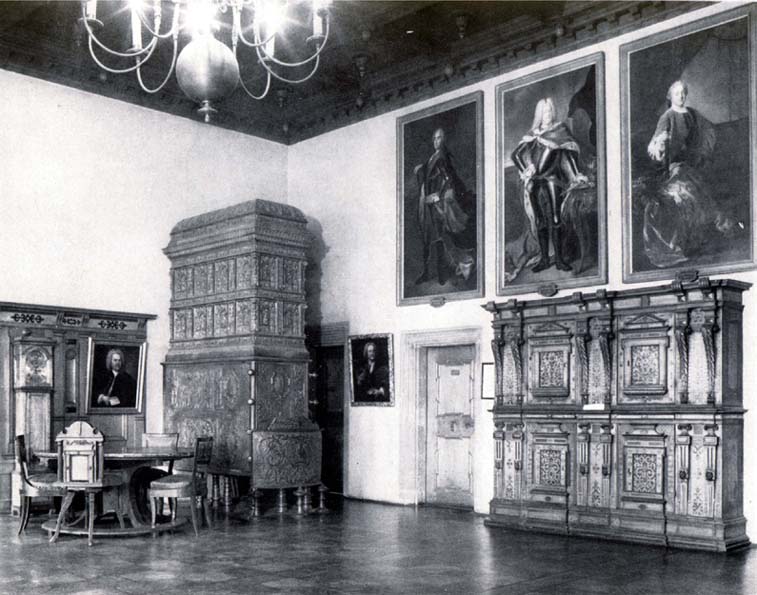
In this photograph one sees not only the original of the 1746 Haussmann portrait of Bach but also the original of the 1727
Haussmann portrait of the brilliant brass player, Gottfried Reiche (1667-1734), for whom Bach wrote a number of his most florid
tromba and clarino parts. These portraits are the same size. On the wall above the elaborately carved Renaissance cabinet are
monumental portraits of the three generations of high Sachsen potentates; these portraits also are all the same size.
"In any case the legend of the painting being hung on the organ at Kittel's request and it strange fate during the
Napoleonic Wars loses credibility in the face of the auction catalogue dated six months after Kittel's death."
Not necessarily. Is the following scenario beyond the realm of possibility?
A friend who knows what Kittel's clearly expressed intentions were is irate that those intentions are being disregarded by the
fiduciaries of his Estate. The friend buys the painting at the sale and gives it to the church to be hung on the organ of the
Predigerkirche in the way that Kittel had directed.
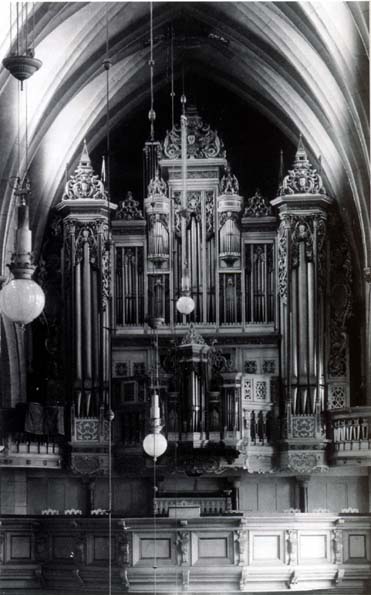
Under such circumstances it would be easy to reconcile the anecdote that Schweitzer repeats with the historical record.
Whether the painting made it to the organ loft of the Predigerkirche or not, one thing is certain:
The portrait in oils of Johann Sebastian Bach that was the treasured possession of his disciple Johann Christian Kittel vanishes from
sight after that auction in Erfurt in October of 1809, and it has remained hidden ever since.
Over the course of the three decades that have elapsed since I graduated from Princeton, I have pondered the conundrum of the
portrait that belonged to Kittel from time to time, but, of course, I turned my mind and energies to more urgent matters. I thought
about it, however, when I was commisioned to produce the first American release of Helmuth Rilling's integral series of recording
of the Bach Cantatas for the Musical Heritage Society. There was enough money in the budget to commision original cover art,
and I took advantage of the opportunity to ask a good and sympathetic friend, Angelo Romano, a talented realist painter who died
much too young, to paint me a portrait of Bach. I lent him photos of the 1748 Haussmann portrait and the Volbach portrait to use
as models. He did a pencil drawing and an oil sketch. The oil sketch ended up on the booklet cover, and the original oil still hangs
on the wall in my bedroom.
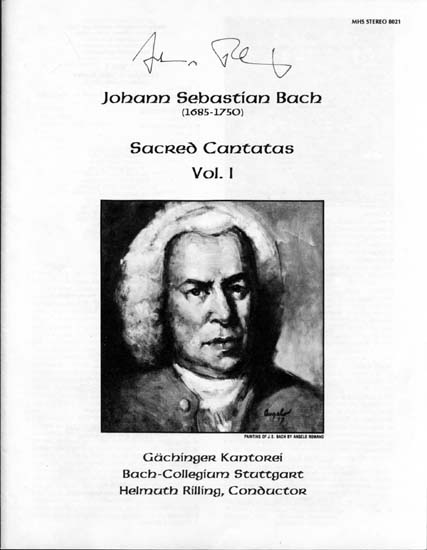
I thought about the whereabout of Kittel's portrait during the tercentenary celebrations of Bach's birth, when the arrival on the scene
of the group portrait that some contend depicts Bach and three of his sons caused a big fuss.
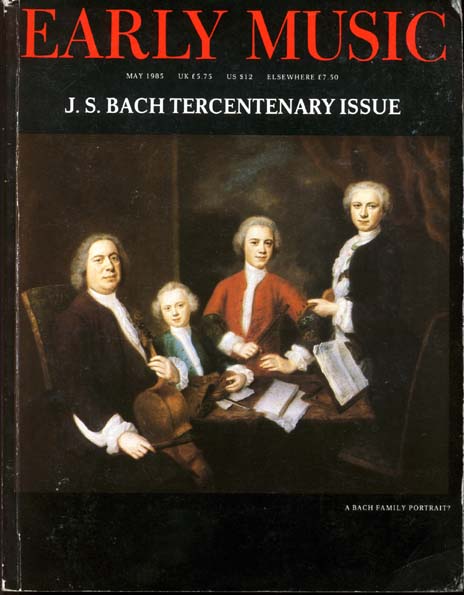
The Kittel Portrait mystery passed through my mind yet again in 1989, when I visited Leipzig for the first time and saw both the full
length statue of Bach by Carl Seffner that stands on a high pedestal in the Thomaskirchof and one of the portrait busts that Seffner
created at the time that he worked with Wilhelm His on the Exhumation Report on Bach's remains.


The conundrum of the portrait that belonged to Kittel was one of the reasons I began a page devoted to the Bach portraits at my
home pages on the internet. Incomplete and inexact though it may be, that initial effort is still there as a cyber-document that now
has, as you will soon learn, a certain historical significance, complete with one particularly ghastly gaffe, but, at least, I am in good
company with that boo-boo. Charles Sanford Terry, the Philipp Spitta of his generation, made the same mistake!
And, I confess, I have fantasized about walking into an antique store or consignment shoppe somewhere and spotting Bach in
official regalia, gathering dust in his ornate gilt frame, waiting patiently to be identified and rescued by a sentimental and perhaps
certifiable "crazy" like me.
Please click on 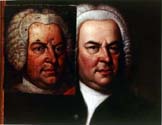 to advance to Page 3.
to advance to Page 3.
Please click on 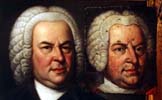 to return to the Index Page at The Face Of Bach.
to return to the Index Page at The Face Of Bach.
Please click on  to visit the Johann Sebastian Bach Index Page at Teri Noel Towe's Homepages.
to visit the Johann Sebastian Bach Index Page at Teri Noel Towe's Homepages.
Please click on the 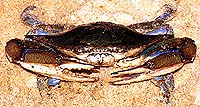 to visit the Teri Noel Towe Welcome Page.
to visit the Teri Noel Towe Welcome Page.
TheFaceOfBach@aol.com
Copyright, Teri Noel Towe, 2000 , 2002
Unless otherwise credited, all images of the Weydenhammer Portrait: Copyright, The Weydenhammer Descendants, 2000
All Rights Reserved
The Face Of Bach is a PPP Free Early Music website.

The Face Of Bach has received the HIP Woolly Mammoth Stamp of Approval from The HIP-ocrisy Home Page.